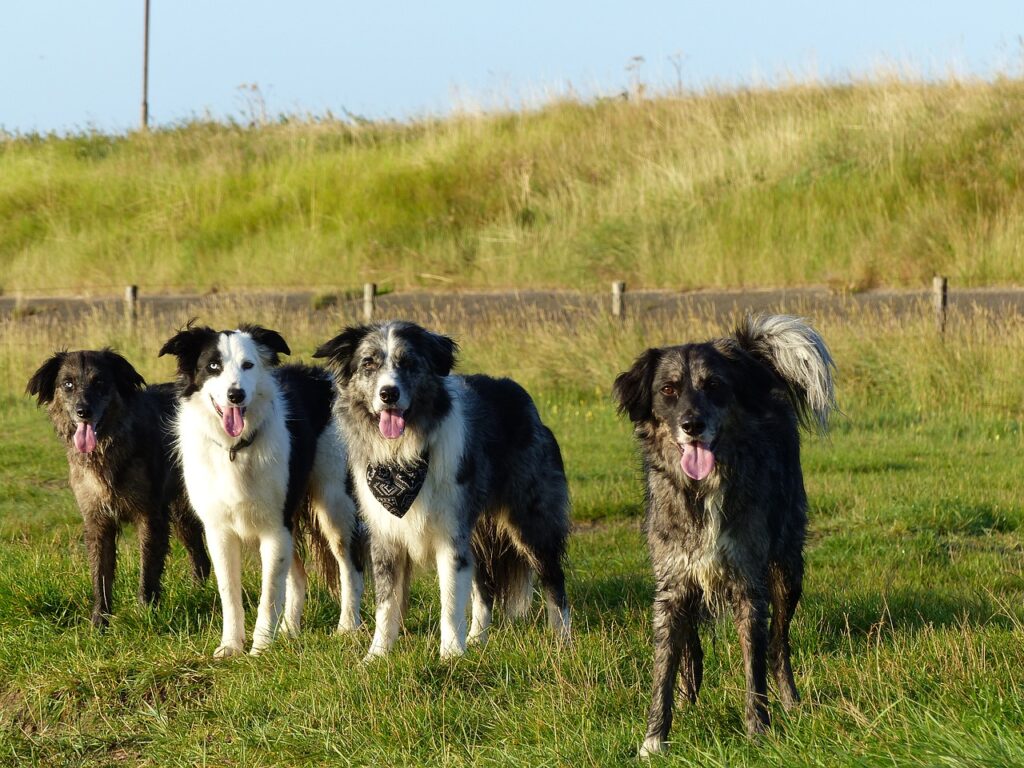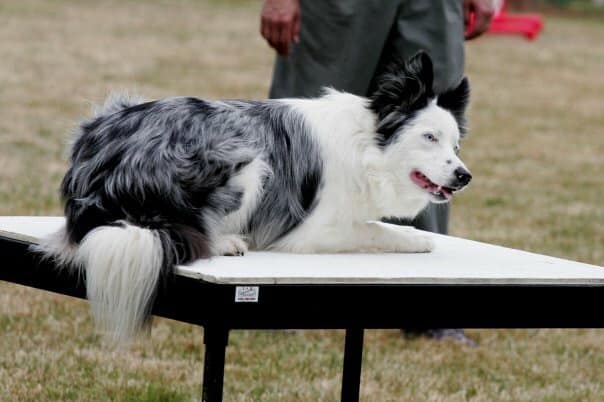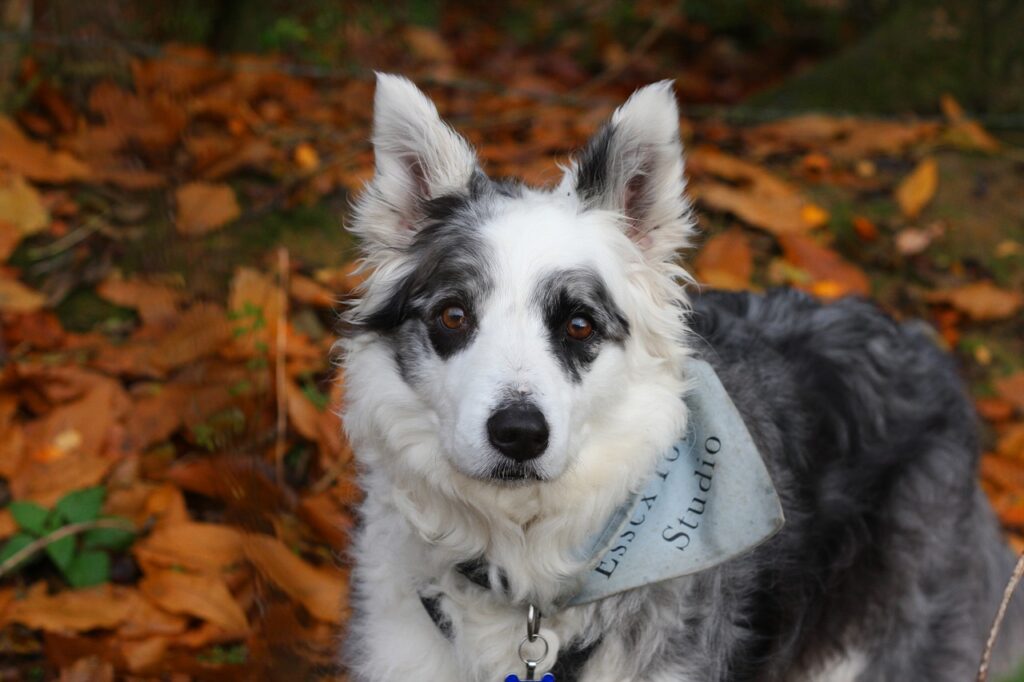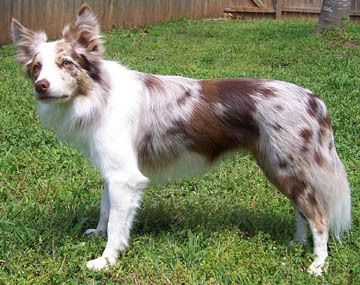Arguably the best working dogs globally, Border Collies are adorable, intelligent, and loyal dogs that value work above everything else.
Famed for their cute looks, Border Collies’ outstanding drive to work and strong desire to keep their subjects together at all times often come as a surprise for people who may know them only for their startling herding roles in movies.
If you are thinking of welcoming a Border collie into your home, you probably want to go for the cutest breed: blue merle Border Collies.
And understandably so, they are exceptionally gorgeous.
But what is it about blue merle Border Collies that make them so endearing to most people?
Well, to help you understand the blue merle border collies’ world better, we’ll explore their background, behaviors, physical characteristics, personality, health, and many other aspects of this amazing dog breed.
Let’s dive in.
Physical Characteristics
- Coat color: Grey or blue-tinged with white chests. The latter may have dark patches on their ears, face, tails, and back.
- Height: 18-22 inches
- Weight: 30-55 Pounds
- Male vs. female size: Males are bigger than females.
- Eyes: Brown and blue eyes OR one brown & one blue eyes and vice versa.
- Ears: Short ears that often stand erect or semi-erect/flop forward depending on their moods
- Tail: Long and low-set
- Nose color: Almost always match their coat colors
How the Merle Color Comes About
First of all, you should note that the word “Merle” is derived from the fact that the main coat color is diluted, leaving spots, splotches, and streaks that give off a ‘bluish’ appearance.
Merles don’t just occur—one of the parents must carry the merle genes.
In a normal case, a pure black gene will dominate red.
However, in case one parent is a merle gene carrier, the gene dilutes the dominant black color creating patterned splotches and patches.
It is also important to note that a merle parent is likely to produce merle puppies but a non-merle border collie cannot produce merle puppies.
However, just because a parent is a merle doesn’t mean that it will automatically give birth to a merle puppy.
Blue Merle Border collie Eyes
As aforementioned, the eye color of this amazing breed can be brown, blue, or one can be brown & one blue and vice versa.
As you can guess, these unique color combinations come about due to genetics.
Unfortunately, the gene that causes these unique eye coloring is often associated with a wide range of eye abnormalities such as cataracts, blindness, corectopia (off-center pupils), heterochromia (one eye is blue and the other brown), and microphthalmia (small eyes).
Coat type
Blue merle Border Collies come in two main types of coats:
- Rough-coated collies: Have medium and longer coats
- Smooth-coated collies: Have short and thick coats
Blue merle Border Collies vs. Australian Shepherds

People tend to confuse blue merle Border Collies (or border collies in general) with Australian Shepherds because they are both herding dogs and their physical differences are few and far between.
Here are quick tips to help you differentiate between the two breeds:
- Type of Coat: Border collies have rougher and denser coats.
- Size: Australian Shepherd’s stature is a bit bigger and heavier.
- Appearance: Border collies have more color shades (mottled, black and white, red/white, blue/white, chocolate/white, blue merle, red merle, and sable/white) than Australian shepherds (red, black, merle, red tricolor, and blue merle).
Personality and Temperament
There is no evidence that the color of a dog’s coat has any effect on his personality and temperament.
Like human beings, personality differs on an individual level and not along color lines.
A Border collie is a Border collie. So, a blue merle Border collie should be:
- All-around energetic
- High intelligent
- Loving and fun
- Active and extremely athletic
- Keen on herding things around him
- Craving for attention and may suffer from a bit of separation anxiety when nobody is around him
Related Post: Why Do Border Collies Hug?
Herding Instincts
Like other Border collies, blue merle Border collies have innate herding instincts, making them perfect dogs for people who are looking to keep livestock under control or who love working in farm settings.
Their boundless energy, work ethic, and ability to learn fast are some of the top traits why many farmers believe they are invaluable breeds.
If you are in a town setting, just know that a blue merle Border collie has herding instincts.
So, don’t be surprised if your pets and children end up being herded from time to time.
Training and Exercise
Given that border collies are smart and energetic, your blue merle Border collie needs plenty of exercises and consistent training to keep him occupied.
Don’t leave your blue merle Border collie to get bored because they can be depressed or become troublesome.
But this doesn’t mean that you have to employ a dog walker to keep up with the energy requirements of this dog.
An hour-long walk once a day and a bit of backyard playtime should suffice.
Being an intelligent dog, training a blue merle Border collie is easy. In fact, they can be trained to do a lot of household chores, including taking out the garbage, sorting laundry, and even loading the dishwasher.
Not convinced? Well, watch this blue merle Border collie help around the house:
Just ensure that you begin any kind of training early enough.
Additionally, like other breeds, don’t expect blue merle Border collie puppies to grasp commands fast.
Pro Tip: While blue merle Border collies are easy to train, always remember that they can be naughty and outsmart you if you are not alert.
Behavior around Children
Certain dog breeds find children confusing and intimidating. Some dogs even find children downright scary!
However, a blue merle Border collie is a friendly dog that gets along with other pets and children.
Just ensure that you socialize him early enough so that he can adapt accordingly.
Related Post: 15 Best Nanny Dog Breeds (Perfect Companions for Kids)
Health issues
Approximately 2.8% of border collies experience unilateral (one ear) or bilateral (both ears) deafness.
Although you can tell if your dog is bilaterally deaf, it’s not easy to tell if your pooch is unilaterally deaf unless you take him for Brainstem Auditory Evoked Response (BAER) test.
Pro Tip:
Don’t be shocked to learn that the merle gene is susceptible to congenital deafness.
The problem has been reported in over 100 dog breeds and the list is growing.
Check out this Louisiana state university’s list for specific breeds.
Besides congenital deafness, border collies are also susceptible to:
- Epilepsy
- Hip Dysplasia
Grooming

Since most blue merle Border Collies have white faces, they are prone to dirt stains on their faces, paws, and underbelly.
To keep your blue merle Border collie in top shape, therefore, ensure that you groom him on a regular basis to keep his coat, ears, nails, and skin healthy all the time.
Border Collies are also heavy shredders, so be ready to brush him 2-3 times a week to prevent matting.
Related: 15 Best Dog Deshedding Tools & Products Every Dog Owner Should Have
Don’t forget to clean your blue merle Border Collie’s ears regularly as well to prevent potential ear infections from debris build-up.
Regular nail trimming or grinding is also recommended to prevent the nails from splitting.
Diet
Feed your blue merle Border collie with the right amount of food, especially based on his age, size, and activity level.
In particular, ensure that he has a high amount of calories to support his high energy levels.
If he exercises a lot, 900 to 1000 calories per day is recommended.
And if he’s helping you to herd, give him around 1400 calories a day.
Pricing

Blue merle Border Collies are considered to be rare, energetic, and brilliant dogs. So, they are always in demand.
Accordingly, many breeders will charge you more compared to a regular border collie, especially because of their rare, beautiful markings.
On average, expect to pay between $600 and $4500 for a blue merle Border collie puppy.
However, beware of breeders who want to take advantage of you simply because blue merle Border collie puppies are rare.
Although there is some genetic difference in the blue merle Border collie lineage, you don’t have to break the bank to get this particular color or coat pattern.
You should also ensure that you check for the medical records of the dog and his parents to ensure that they don’t have some of the highlighted health issues.
Breeding Tips
As hinted above, for you to get a blue merle Border collie puppy, one parent should be a carrier of the merle gene.
ONLY one parent needs to be merle gene carrier NOT both parents. Why? Well, let’s find out.
When only one parent is a merle gene carrier, there is a 50% chance of getting a blue merle given the randomness of the genetic heritage.
However, when both parents are carriers of the gene, there is high a 25% chance that one of the pups will inherit a homozygous (or double) merle gene.
A homozygous merle gene is not a good gene because it is susceptible to blindness, deafness, and other health issues.
To avoid such risks, therefore, always strive to breed a merle with a non-merle gene carrier.
In the event that two merle gene carriers mate, they should be neutered and spayed to prevent passing on of the gene.
Pro Tip:
Besides the merle and non-merle carriers, there is a third variant of the blue merle Border collie breed known as the cryptic or phantom merle that is black or liver with only a few spots, splotches, and streaks.
Life Expectancy
The average lifespan of a blue merle Border collie is 12 years.
Typically, it can range between 10 and 14 years but some dogs can go up to 17 years.
Are there other color combinations of Border Collies besides the Blue Merle?

Yes. There are a lot of combinations in the Border collie breed. Some of the most common merles include:
- Red Merle: The merle gene breaks the dominant brown base color.
- Slate Merle: Have diluted black, white, and blue coat colors. They are a bit lighter than blue merles.
- Harlequin Merles: Have white coats with black, gray, and brown spots on legs, tail, face, and body.
- Lilac Merle: Have diluted blue and chocolate base, making them appear silver or grey.
- Sable Merles: Have dark brown coats with an orange or pink cast, making them have a rusty blue merle appearance.
Final Thoughts
As you can see, blue merle Border collies are beautiful breeds inside out.
So, if you decide to own one, fully commit to some of the above-highlighted requirements and enjoy your life with your new canine friend.
If you have space for this amazing breed to run around, time to bond with your dog, and you love being active, blue merle Border collie may be the best dog to own.
As an Amazon Associate, we may receive a small commission from qualifying purchases but at no extra cost to you. Learn more. Amazon and the Amazon logo are trademarks of Amazon.com, Inc, or its affiliates.

